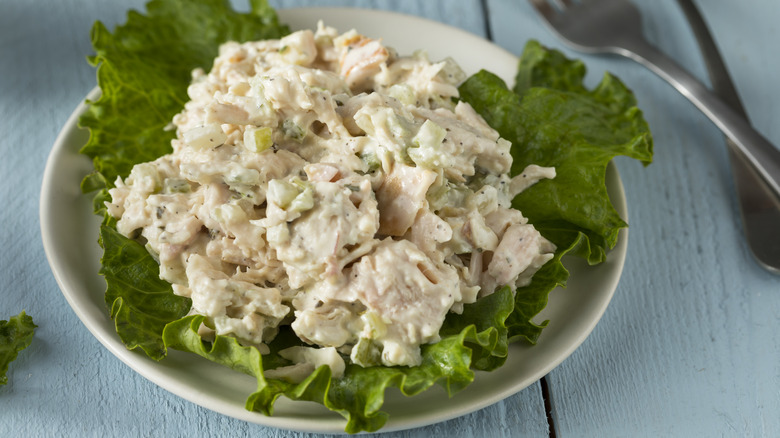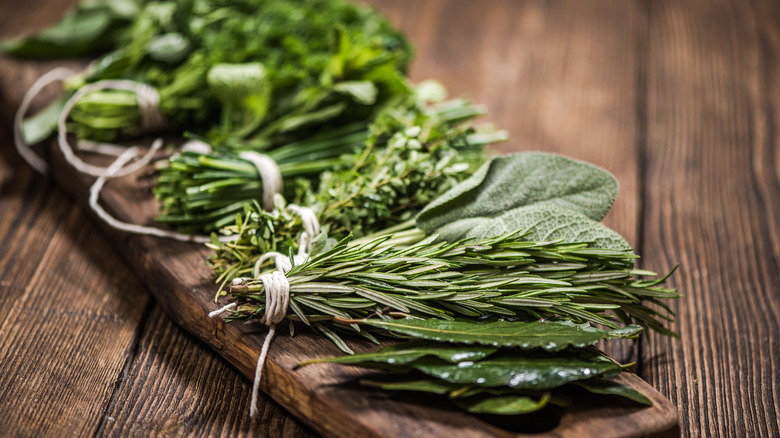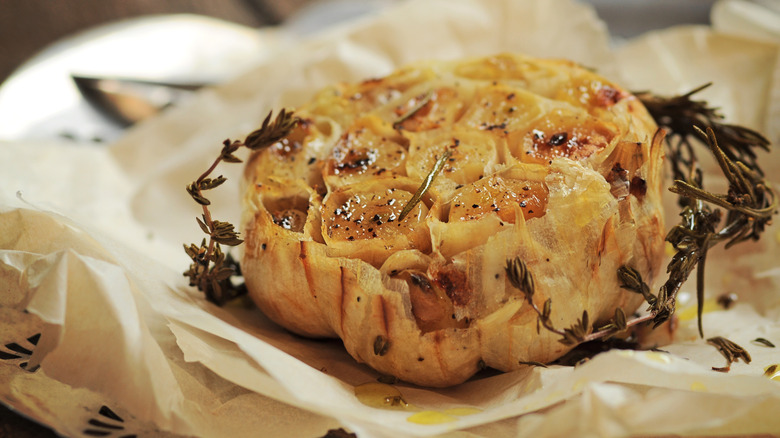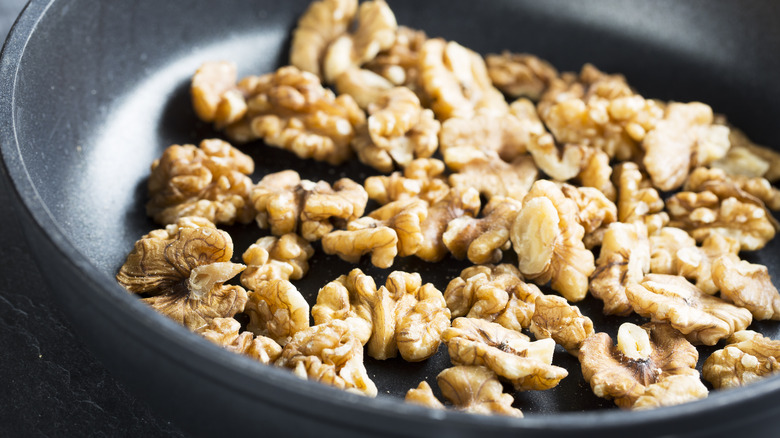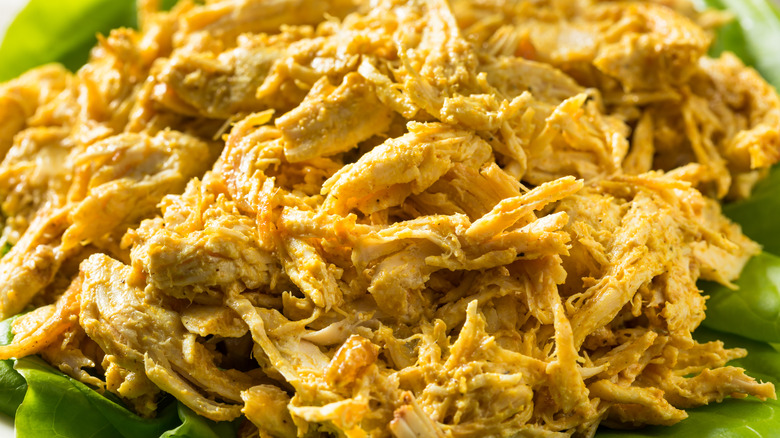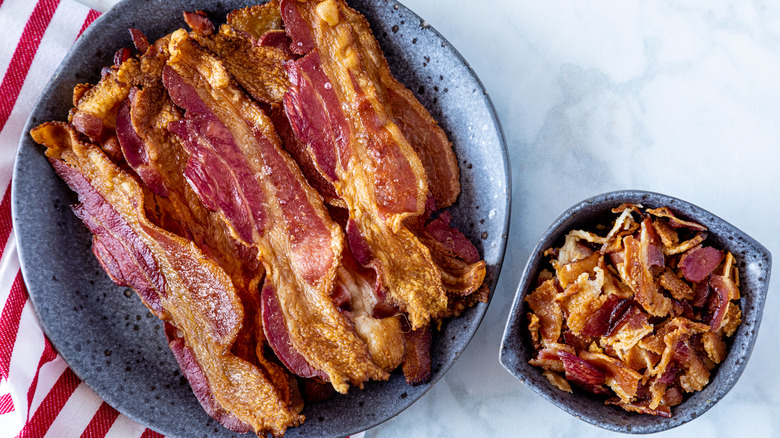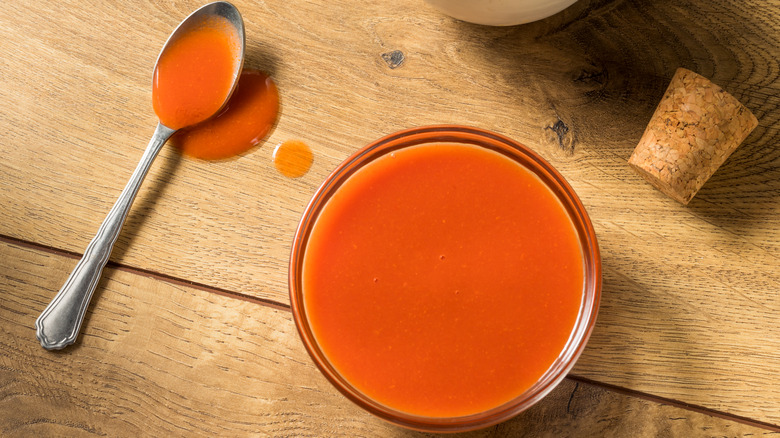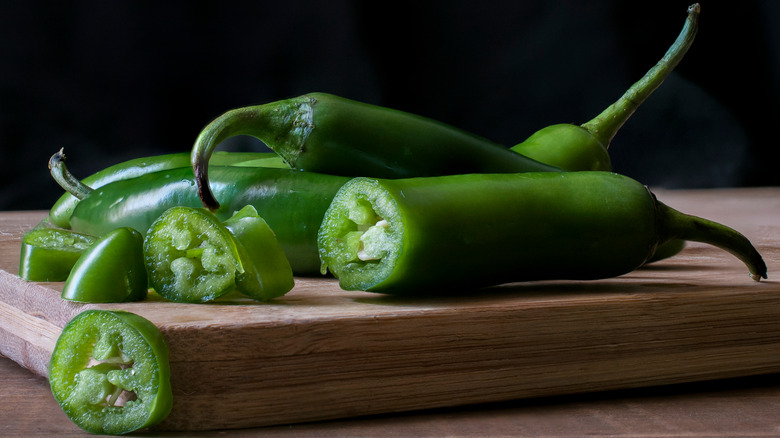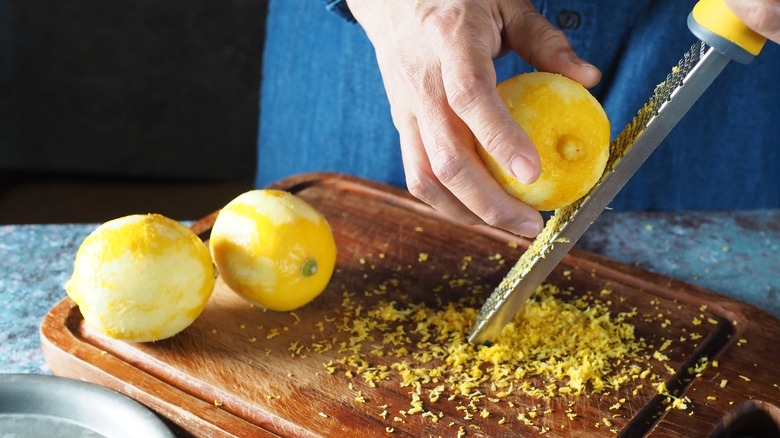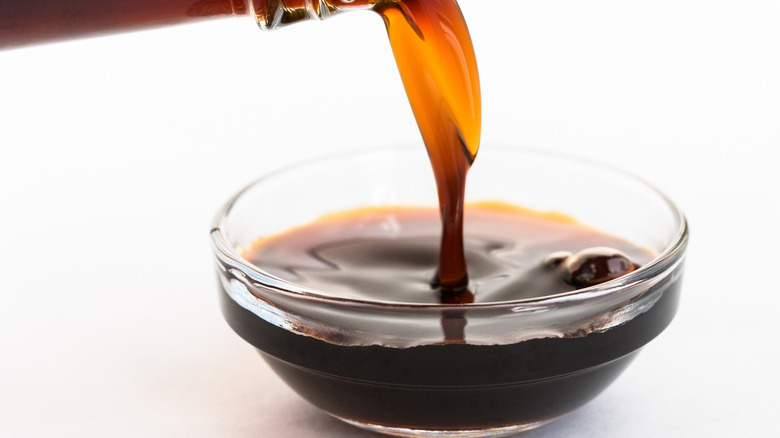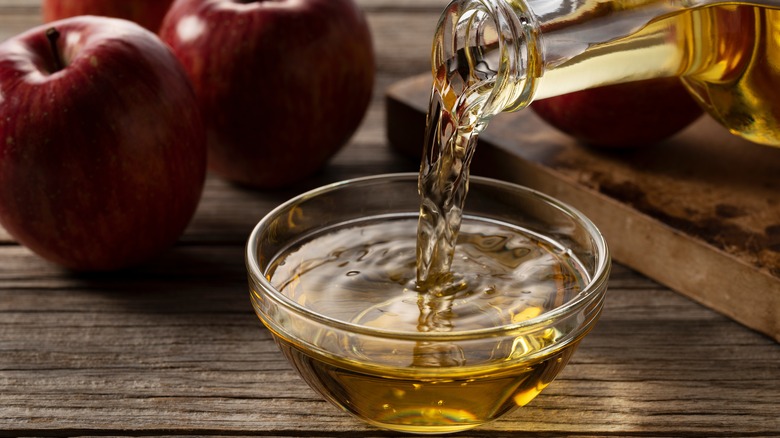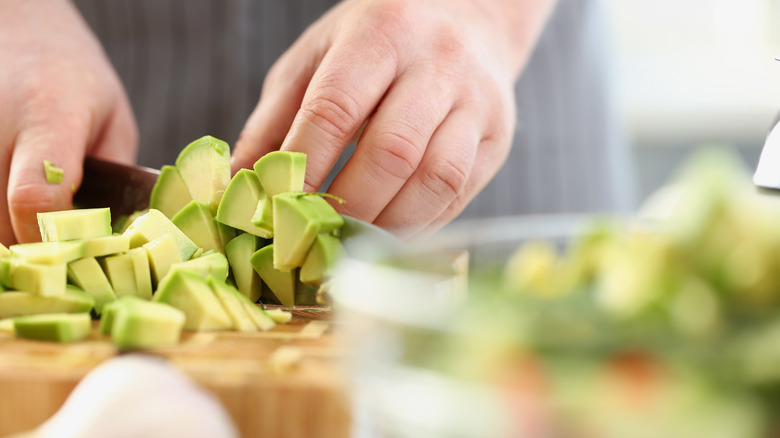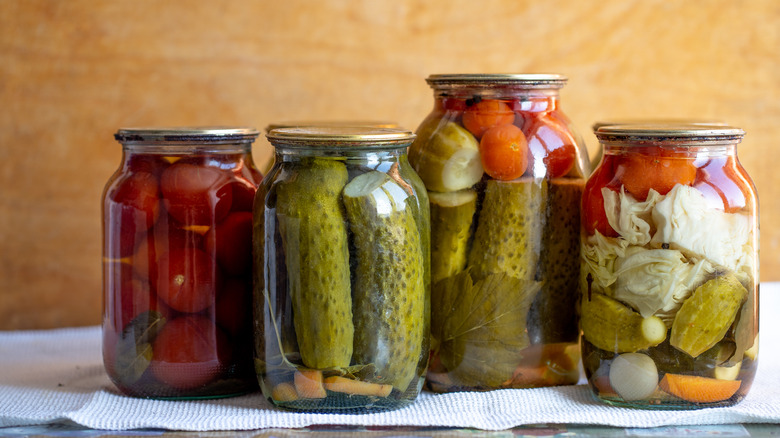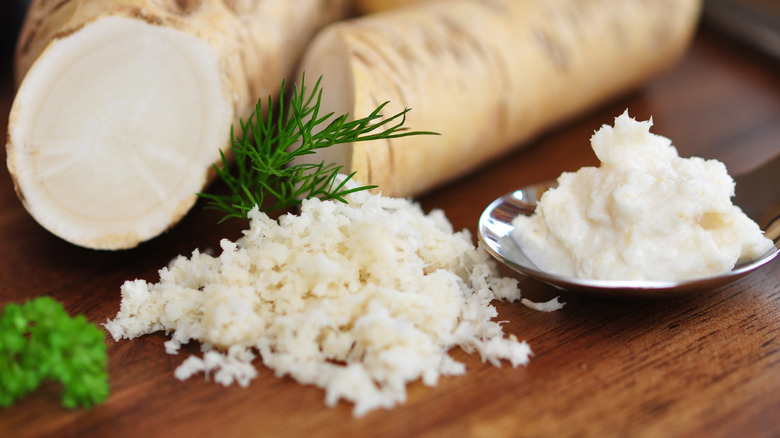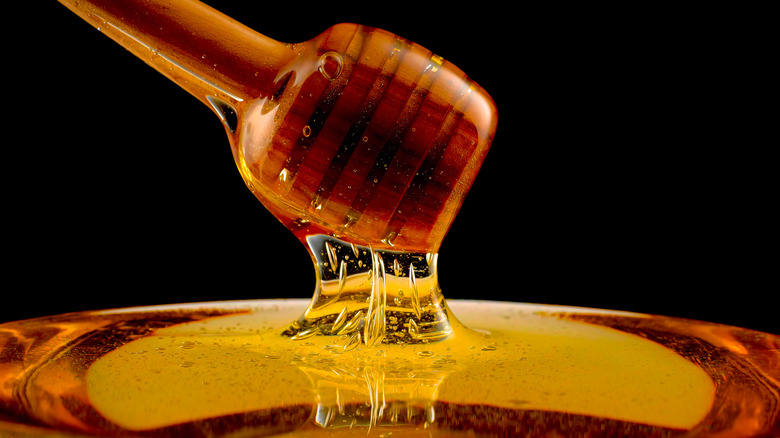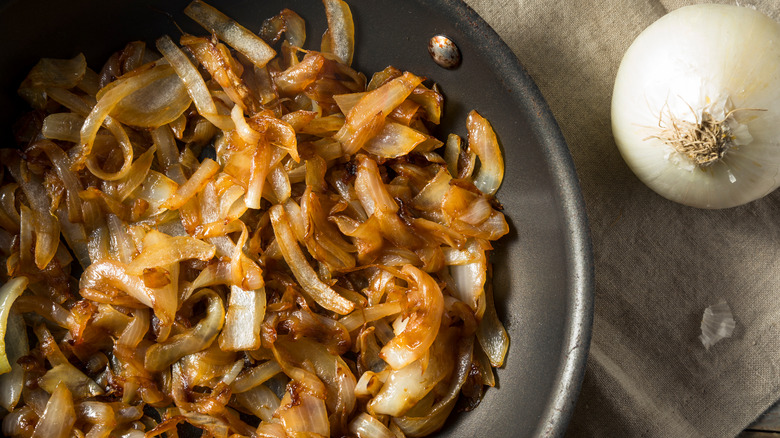15 Ingredients That Will Take Your Chicken Salad To The Next Level
As with most food history, the origin of the chicken salad that we know of today is murky. What we do know is that mayonnaise and cold chicken were being combined since at least as early as the mid-1800s, when the owner of a meat shop in Wakefield, Rhode Island, looking for a way to use his leftover chicken, threw together a mixture of mayonnaise, grapes, and tarragon. It proved to be so popular he changed his business model to revolve around it.
Today there are countless variations of chicken salad with wildly different flavor profiles, from sweet to spicy, light and fresh to decadent and rich. They all contain chicken of some kind, usually either shredded or diced, along with a binding dressing, typically mayonnaise-based. Beyond that, chicken salad can be a canvas upon which anyone can express their culinary creativity. There are an infinite number of ingredients that you can add to elevate your chicken salad, adding freshness, intensity, and texture. Here are the best options to make sure your chicken salad reaches the next level.
1. Fresh herbs
Chicken and mayonnaise are both mild enough in flavor that just about any herb, or combination of herbs, will complement a chicken salad. It all depends on the taste profile that you're going for. If there's a particular fresh herb that you love with chicken, add it to the salad alone to showcase its singular flavor. If you're looking for more complexity, a blend of herbs will add more layers.
Fresh basil or tarragon will add a subtly pungent, light anise note to your salad –- if you're a fan of this flavor, you can add both herbs to really punch it up. Chervil and dill are both delicate herbs that will add a softer character, good if you want to keep your salad mellow. Thyme, rosemary, sage, and parsley complement each other well and impart a distinctive Mediterranean flair to chicken. For a Latin cuisine feel, try a blend of oregano, cilantro, and epazote.
2. Roasted garlic
Roasted garlic is one of the easiest ways to add richness and depth of flavor to chicken salad. If you happen to be roasting chicken for the dish anyway, all you have to do is add a few bulbs of garlic to the oven alongside your bird. Even if you're using pre-cooked chicken or a different preparation method, roasting garlic is a mostly hands-off endeavor, and it's worth it for the serious flavor boost it'll give your salad.
A little time and a few simple steps is all it takes to make roasted garlic. Once you have a fully-cooked bulb, you should be able to easily squeeze the soft cloves out of their papery skins and mash them into a paste. Season to taste, and then mix this paste into your dressing to add a comfortingly rich, nutty, slightly sweet garlic flavor that will bring depth and warmth to your chicken salad.
3. Toasted nuts and seeds
The main thing missing from a salad that's just chicken and mayonnaise is texture. Tender chicken and creamy dressing may taste fine, but without a bit of crunch, every bite will seem boring. One of the best ways to upgrade your chicken salad is to add ingredients that have some bite to them, like nuts and seeds. While you can certainly add them as-is, you'll get more depth of flavor if you toast them first.
Any combination of toasted nuts and seeds will add not only flavor and texture to your chicken salad, but nutrition as well. Protein, unsaturated fats, and fiber are found in these little powerhouses, per Harvard Health Publishing, and some have extra bonuses like B vitamin-rich peanuts and calcium-packed almonds.
To pack the biggest flavor punch to your chicken salad, you can season your nuts and seeds before toasting or roasting them, like these Chili-Roasted Pumpkin Seeds. And while using the oven or stovetop are the most common methods, for ultimate convenience you can use your microwave to achieve the same effect.
4. Curry powder or other spice blends
Chicken salad is no stranger to curry seasoning. The now-classic British dish Coronation Chicken has been around since 1953, when it was served at a luncheon in honor of Queen Elizabeth II at Le Cordon Bleu culinary school in London. It consists of roasted chicken, cooled and taken off the bone, and mixed with a creamy curry sauce that is typically mayonnaise-based. This variation on chicken salad makes one wonder what other seasoning blends might take chicken salad to the next level.
Old Bay, though it's best known for seafood, is a deliciously warm and zesty spice blend to add to chicken salad, too. Creole seasoning can be used to add deep, savory flavor and a kick of heat from cayenne pepper. Balance and complexity are what five-spice powder brings to the table, with plenty of peppery heat and warmth. Or you can go all-American with good old-fashioned ranch seasoning, a great match with chicken. Mix any of these blends into your dressing and you'll have a flavor-packed chicken salad.
5. Bacon
One of the great things about chicken salad is that you can make it as light or as indulgent as you'd like. If you're in the mood for a more rich and flavorful version, adding bacon is pretty much a must. Bacon adds not just extra flavor, but also fat, salt, and texture, all in one little ingredient. It's a lot of bang for your buck.
Since the bacon will likely be sitting in dressing for a while once the salad is assembled, you'll want to make sure it's as crispy as possible so it maintains its crunch. Depending on the texture you like, you can use thin or thick strips and slice, chop, or crumble them to the size and shape of your choosing. Or you can buy slab bacon or pancetta and dice it into chunky cubes for a meatier, more toothsome texture. To add even more rich bacon goodness, save some of the fat from cooking and blend it into your dressing. Your chicken salad will have a salty, savory, smoky quality all the way through.
6. Hot sauce
If you find your chicken salad is in need of a little oomph, a great way to rev up flavor is to add some heat, and mixing some hot sauce into your dressing is an easy way to achieve that. Whether you want to go full Buffalo-style and turn your chicken red hot, or just dash in a few drops to add a subtle background heat is up to you –- either way, you're turning up the flavor.
There are thousands of hot sauces on the market and each has its own unique taste and texture. It helps to know some of the basic styles and become familiar with heat levels so that you can match your personal taste preferences and chile tolerance. Cajun or Louisiana style hot sauces, like popular brands Tabasco and Crystal, have a vinegar tang that brightens up chicken salad, as well as adding heat. Frank's RedHot, which is specifically made for chicken, falls under this category.
Others to consider are Mexican hot sauces such as Cholula, which tend to have a thicker consistency and deeper chile flavor, green chile sauces for a more mild chile bite, and sriracha which brings an intense garlic flavor along with its heat. This is merely a tiny smattering of the world of hot sauces –- experimenting with different styles will help you find the perfect heat and flavor for your chicken salad.
7. Chili peppers
If you're looking to add fresh, bright spice to your chicken salad, adding chile peppers may be the way to go. They can be diced, sliced, minced, or pureed and added to the dressing to bring a zesty heat. What chiles you use and how depends on the level of intensity you're looking for, so it helps to know a few chile pepper basics.
First, always use caution when preparing fresh chiles, as when their oils touch your skin they can cause a burning sensation -– be particularly careful to not touch your eyes. Keep in mind that just because a type of chile is labeled with a specific heat level, such as mild or hot, each individual chile can vary. Make sure to smell and taste each pepper before you add it to your dish so you know how much you need. The seeds and membranes are hotter than the flesh, so remove them if you want a mellower heat.
For mild to moderate heat, a few common types are banana peppers, poblanos, and Anaheim peppers. For more of a punch, go for a jalapeño or Fresno. Serrano and cayenne peppers are another step up, and then you jump into true fiery territory with habaneros. All of these will add fresh, fruity flavor and a kick of heat to your chicken salad.
8. Citrus juice and zest
Chicken and citrus are natural companions. The acidity in citrus juice makes its flavor pop, bringing excitement to mild white meat and brightness to rich dark meat. It also balances out fat, which helps lighten up mayonnaise-based chicken salad dressings. If you're not adding citrus juice to your chicken salad, you are missing out on these dimensions of flavor.
It's not just the juice that can be used to liven up chicken salad, however. For extra bright, fragrant citrus notes, grate the zest of the fruit and mix it into the dressing. The oils in the outer layer of citrus peels release fresh aromas and zippy bright flavors –- just don't grate too far or you'll reach the white, bitter pith underneath.
While lemon and lime are common additions to chicken salad, there's a world of citrus fruits with a vast range of flavors and aromas that you can utilize to brighten the dish. Chicken and orange are no strangers to one another (as the huge popularity of Orange Chicken can attest), so why not add a little orange juice or zest to chicken salad? Experiment with other unique citrus fruits, like aromatic yuzu or tangy pomelo, to add new layers of brightness and aroma to chicken salad.
9. Liquid aminos, tamari, or soy sauce
Adding liquid aminos, tamari, or soy sauce to chicken salad is a quick and simple way to deepen the flavor of the dish. All three of these umami-packed sauces bring similar flavors to the table, with subtle differences in the way they're made and how they taste, but each is a fantastic flavor-boosting addition to chicken salad.
Soy sauce is likely the most familiar of the three, found on the tables of sushi spots and Chinese restaurants everywhere. Both soy sauce and tamari are made by fermenting soybeans, but unlike tamari, soy sauce also includes wheat. Liquid aminos are made from soybeans as well, but rather than fermentation, they go through a treatment process that breaks down their proteins. These processes and ingredients lend slightly different flavors to each: Tamari is richer and darker, with a deep and complex fermented flavor. Soy sauce tends to be lighter and somewhat saltier, while liquid aminos have a mellower, more straightforward flavor due to the lack of fermentation.
When adding these sauces, make sure you are periodically tasting for seasoning. Since all three of these sauces add saltiness, you might find you need to add less salt or even none at all to your chicken salad.
10. Vinegar
A few spoonfuls of vinegar added to chicken salad can really make its flavors sing. A lack of acidity is often the culprit when a dish is tasting flat or bland, and vinegar is a pantry staple that can easily rectify such a situation. There are a multitude of vinegars out there, each with a different flavor profile and intensity level. Some are neutral and will amplify flavors from the background, while others will add their own unique taste to the salad.
Like soy sauce, vinegar is a fermented product. The wide range of vinegars on the market is due to the fact that they're made from a vast variety of starting ingredients, including fruit, rice, and wine -– if it can be fermented, it's fair game for vinegar production. Mild options include rice and white wine vinegars, good additions to chicken salad if you want to keep the flavors light. Sherry and red wine vinegars have a more pronounced taste. For a fruity vinegar flavor, apple cider is a great choice, especially if you have fruit in your chicken salad. And if you're going for a richer style of chicken salad, balsamic vinegar will add layers of intensity, viscosity, and sweetness.
11. Avocado
Avocado, the powerhouse fruit, is packed with vitamins, nutrients, fiber, and healthy fats -– and not only that, it's incredibly versatile. It can be added to chicken salad in a number of different ways, adding flavor, nutrition, and texture all at once.
Once your avocado is separated from its pit and peel, it can be mashed to a paste or pureed to a creamy consistency. You can use it in place of, or in addition to, mayonnaise for your chicken salad dressing, a great option if you are avoiding dairy in your diet. Avocado can also be diced and mixed into the salad for texture. Or you can thinly slice the avocado and place it on top of the salad, which adds visual appeal.
It doesn't matter which way you decide to incorporate this superfood –- you'll be taking your chicken salad to the next level whether it's as a dressing, a filling, a topping, or all three. Try this Avocado Chicken Salad recipe to get the most out of this ingredient.
12. Pickled vegetables
Most chicken salad recipes call for diced celery, which adds a nice fresh crunch to the mixture. Many include shredded carrots. But you can easily upgrade your chicken salad by taking your vegetable ingredients up a notch in flavor and using pickled ones, instead of or in addition to, fresh veggies.
Pickled vegetables add the same crunch and texture as fresh and raw veggies, with the added bonuses of acidity and flavor intensity. Your basic store bought dill pickles –- or sweet pickles, if that's your preference -– will do nicely. If you love a kitchen project, making your own pickles is a rewarding and largely hands-off affair, and you can pickle pretty much any vegetable imaginable. From green beans to turnips, to the more traditional cucumbers, any pickled vegetable will add bright, briny flavor and satisfying crunchiness to chicken salad.
Pickling does take a while, so if you're short on time, you can use a quick pickle method. Try these Cheater's Pickles, which are almost instantaneous -– they won't last as long as traditional brined pickles, but they'll do the job in a pinch.
13. Horseradish
Horseradish can be something of a divisive ingredient, with an intense, sinus-clearing heat that thrills some and repels others. While it may be best known as a crucial component in a Bloody Mary, its unique ferocious bite and hot mustard-esque flavor can be a delicious addition to chicken salad.
Prepared horseradish is typically sold in jars with vinegar, which mellows its heat somewhat, and often other ingredients as well, like spices and oil. It can also be found in its natural form as a root that can be ground or grated, but the jarred stuff is much more convenient. Since it has the consistency of a condiment, it can easily be mixed into chicken salad dressing.
However, if you're looking for the ultimate punch of heat and flavor, fresh horseradish is much more potent. Once the rough edges are peeled off, you can grate it, shave it, chop it, or grind it using a food processor. The difference in intensity between prepared and fresh horseradish is extreme, so be cautious with the amount you add. Fresh or prepared, it makes sense to use a light hand when mixing horseradish into your chicken salad, but the fiery flavor will definitely take the dish to another level.
14. Honey
Mixing honey into chicken salad dressing gives the dish a touch of sweetness and richness, with more dimension than you'd get from simply adding sugar or other sweetening agents. Honey and chicken are a natural match, as recipes like Honey Garlic Chicken Wings and Sesame Honey Chicken demonstrate. The rich, fragrant flavors and aromas of honey complement the mild flavor of chicken well.
There are hundreds of different types of honey in the U.S. alone, and many more around the world. Honey is named after the type of flower from which the nectar is collected, such as orange blossom honey and Tupelo honey, and these tend to be produced regionally based on where those flowers grow. Common store-bought honey is typically made from a blend and pasteurized for stabilization, and it may lack the flavor intensity of other styles.
Honey is particularly useful to balance out other flavor sensations. If you find your chicken salad too spicy or salty, mix in some honey.
15. Caramelized onions
Caramelized onions add so much deep, rich flavor when added to chicken salad, it almost feels like using a cheat code. Unlike raw, pickled, or grilled onions, caramelized onions develop a uniquely savory-sweet flavor and a soft, jammy consistency that add layers of taste and texture. However, caramelizing onions correctly takes time, attention, and know-how, or you may end up with a burnt mess.
The key to properly caramelizing onions is to take your time. Depending on your method, caramelization can take anywhere from 20 minutes to over an hour. You don't want to rush it, as onions can easily burn once their moisture cooks off. The fat you choose is also important -– a combination of butter and oil is a good option, as long as you make sure the oil has a high smoke point, such as avocado. Adding liquid as they cook can help ensure burning doesn't occur, as in this Foolproof Caramelized Onions recipe.
Static Media owns and operates Daily Meal and Tasting Table.
